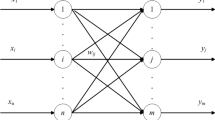In this paper we report on continuing research on the organization and functionalities of a certain type of computer-implemented associative memory. The associative memory in question is being created to serve as part of a feature-based design system, at present to be used primarily in support of the design, fabrication planning, or inspection planning of discrete mechanical machine parts. This present effort is consonant with prior related work in the realm of case-based reasoning, especially as related to the role of memory in design. Our associative memory innovations are in the use of fuzzy sets and neural net computing in the representation, storage and retrieval of design, fabrication, inspection and materials knowledge. We have designed and implemented a considerable portion of the associative memory and have demonstrated retrieval of previous designs on the basis of qualitative geometry. We have also demonstrated ability to explore materials composition with the objective of meeting critical materials properties constraints.
Similar content being viewed by others
References
Ansaldi, S., Boato, L., Del Canto, M., Fusconi, F. and Giannini, F. (1989) Integration of AI techniques and CAD solid modelling for process planning applications, in Proceedings of Computer Applications in Production and Engineering (CAPE '89), Kimura, F. and Roisstadas, A. (eds), North-Holland Publishing Co., Amsterdam, pp. 351–364.
Cross, N. (1989) Engineering Design Methods, John Wiley & Sons, Inc., New York, NY.
Descotte, Y. and Latombe, J.-C. (1981) GARI: A problem solver that plans how to machine mechanical parts, in Proceedings of the International Joint Conference on Artificial Intelligence, IJCAI-81, pp. 766–772.
Filho, E. V. G. (1988) Computer-aided group technology part family formation based on pattern recognition techniques, PhD thesis, Department of Industrial and Management Systems Engineering, The Pennsylvania State University.
Fridshal, R. (1984) Automatic generation of NC instructions from geometric models, in Proceedings of the Symposium on Computer Integrated Manufacturing, ASME Winter Annual Meeting.
Hammond, K. J. (1989) Case-Based Planning, Academic Press, Inc., San Diego, CA.
Iwata, K. and Sigimura, N. (1984) A knowledge based computer aided process planning system for machining parts, in Proceedings of the Sixteenth CIRP International Seminar on Manufacturing, pp. 83–92.
Kamarthi, S. V. (1990) An investigation into the application of neural networks for component design retrieval, Unpublished MS thesis, Department of Industrial and Management Systems Engineering, The Pennsylvania State University.
Kamarthi, S. V., Kumara, S. T., Yu, F. S. and Ham, I. (1990) Neural networks and their applications in component design data retrieval, Journal of Intelligent Manufacturing, 1, 125–140.
Kolodner, J. (1980) Retrieval and organizational strategies in conceptual memory: a computer model, PhD thesis, Yale University, New Haven, CN.
Kumara, S. R. T. and Ham, I. (1990) Use of associative memory and self-organization in conceptual design, Annals of CIRP, 40, 117–120.
Maher, M. L. (1989) Synthesis and evaluation of preliminary designs, in Proceedings of the Fourth International Conference on the Applications of Artificial Intelligence in Engineering, pp. 3–14, Computational Mechanics Publications, Southampton, UK.
Maher, M. L., Zhao, F. and Gero, J. S. (1989) An approach to knowledge-based creative design, in Proceedings of NSF Engineering Design Research Conference, pp. 333–346.
Mantyla, M. and Opas, J. (1988) HutCAPP - A machining operations planner, in Proceedings of the International Symposium on Robotics and Manufacturing Systems (ISRAM), pp. 901–910, ASME, New York, NY.
Mantyla, M., Opas, J. and Puhakka, J. (1987) A prototype system for generative process planning of prismatic parts, in Modern Production Management Systems, Proceedings of AOMS'87, Kusiak, A. (ed.), pp. 599–611, North-Holland Publishing Co., Amsterdam.
Minsky, M. (1980) K-Lines: A theory of memory, Cognitive Science, 4, 117–133.
Nau, D. A. and Gray, M. (1986) SIPS: An application of hierarchical knowledge clustering to process planning, in Integrated and Intelligent Manufacturing, Proceedings of the Winter Annual Meeting of ASME, PED - Vol. 21.
Nau, D. S. and Karinthi, R. R. (1989) Using a feature algebra for reasoning about geometric feature interactions, in Proceedings of Eleventh International Joint Conference on Artificial Intelligence (IJCAI), August.
Nau, D. S. and Karinthi, R. R. (1990) Handling feature interactions in concurrent design and manufacturing, Manufacturing International '90, March, Atlanta, GA.
Pao, Y. H. (1988) Artificial neural-net as models for multivalued logic, in Proceedings of International Multi-valued Logic Conference, Mallorca, Spain, May 24–26.
Pao, Y. H. (1989) Adaptive Pattern Recognition and Neural Networks, Addison-Wesley, Reading, MA.
Pao, Y. H. and Altman, J. F. (1975) Associative memories as multipath logic switches, in Proceedings of the International Conference on Multivalued Logic, Indiana University, Bloomington, IN, May 15–16.
Pao, Y. H. and Altman, J. F. (1976) Use of associated memory in implementing of multivalued logic systems, in Proceedings of the International Conference on Multivalued Logic, Utah State University, UT, May.
Pao, Y. H. and Hartoch, G. P. (1982) Fast memory access by similarity measure, in Machine Intelligence 10, Hayes, J., Michie, D. and Pao, Y.-H. (eds), Edinburgh University Press.
Pao, Y. H., Schultz, W. L. and Altman, J. F. (1976) Implementation of human judgement and ‘Experience’ in computer aided interpretation of medical images, in Proceedings of Third International Conference on Pattern Recognition, Del Coronada, CA.
Schank, R. C. (1982) Dynamic Memory: A Theory of Reminding and Learning in Computers and People, Cambridge University Press, New York, NY.
van Houten, F. J. A. M., van't Erve, A. H. and Kola, H. J. J. (1989) Part: A feature based CAPP System, 21st CIRP International Seminar on Manufacturing Systems, Stockholm, Sweden.
Zhao, F. and Maher, M. L. (1988) Using analogical reasoning to design buildings, Engineering with Computers, 4(3), 107–119.
Author information
Authors and Affiliations
Rights and permissions
About this article
Cite this article
Pao, YH., Komeyli, K., Shei, D. et al. The episodal associative memory: Managing manufacturing information on the basis of similarity and associativity. J Intell Manuf 4, 23–32 (1993). https://doi.org/10.1007/BF00124978
Issue Date:
DOI: https://doi.org/10.1007/BF00124978




